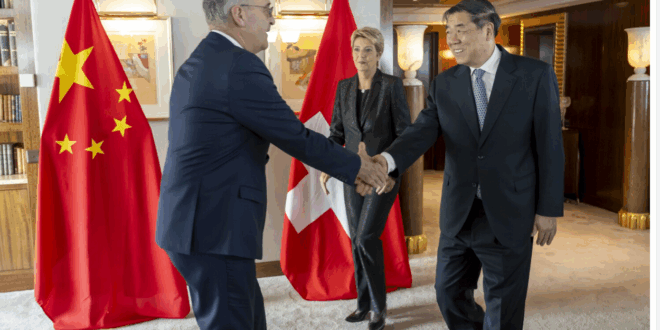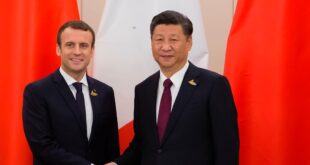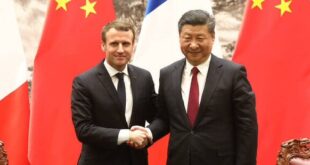Muhamad Yehia .. Cairo
WASHINGTON — The way President Donald Trump sees it, beating China in a trade war should be easy.
After all, his logic goes, the Chinese sell Americans three times as much stuff as Americans sell them. Therefore, they have more to lose. Inflict enough pain, like the combined 145% taxes he slapped on Chinese imports last month, and they’ll beg for mercy.
Trump’s treasury secretary, Scott Bessent has confidently compared Beijing to a card player stuck with a losing hand. “They’re playing with a pair of twos,’’ he said.
Somebody forgot to tell China. So far, the Chinese have refused to fold under the pressure of Trump’s massive tariffs. Instead, they have retaliated with triple-digit tariffs of their own.
“All bullies are just paper tigers,’’ the Chinese Foreign Ministry declared in a video last week. “Kneeling only invites more bullying.’’
The stakes are high between the world’s two biggest economies whose trade topped $660 billion last year. Bessent and Trump’s top trade negotiator, Jamieson Greer, are heading to Geneva this weekend for initial trade talks with top Chinese officials. Trump suggested Friday that the U.S. could lower its tariffs on China, saying in a Truth Social post that “80% Tariff seems right! Up to Scott.
While businesses and investors welcome any easing of tensions, the prospects for a quick and significant breakthrough appear dim
“These are talks about talks, and China may be coming to assess what’s on the table — or even just to buy time,” said Craig Singleton, senior China fellow at the Washington-based think tank Foundation for Defense of Democracies. “There’s no shared roadmap or clear pathway to de-escalation.”
But if the two countries eventually agree to scale back the massive taxes — tariffs — they have slapped on each other’s goods, it would relieve world financial markets and companies on both sides of the Pacific Ocean that depend on U.S.-China trade
“The companies involved in this trade on both sides just cannot afford waiting anymore,” said economist John Gong of the University of International Business and Economics in Beijing. In a worst-case scenario, China could walk away from the negotiations if it feels the U.S. side isn’t treating China as an equal or isn’t willing to take the first step to deescalate, Gong said.
“I think if (Bessent) doesn’t go into this negotiation with this kind of mindset, this could be very difficult,” he said.
For now, the two countries can’t even agree on who requested the talks. “The meeting is being held at the request of the U.S. side,’’ Chinese Foreign Ministry spokesperson Lin Jian said Wednesday. Trump disagreed. “They ought to go back and study their files,” he said.
Trump’s faith in tariffs meet economic reality
What seems clear is that Trump’s favorite economic weapon — import taxes, or tariffs — has not proved as mighty as he’d hoped.
“For Trump, what’s happened here is that the rhetoric of his campaign has finally had to face economic reality,” said Jeff Moon, a trade official in the Obama administration who now runs the China Moon Strategies consultancy. “The idea that he was going to bring China to its knees in terms of tariffs was never going to work
Trump views tariffs an all-purpose economic tool that can raise money for the U.S. Treasury, protect American industries, lure factories to the United States and pressure other countries to bend to his will, even on issues such as immigration and drug trafficking.
He used tariffs in his first term and has been even more aggressive and unpredictable about imposing them in his second. He’s slapped a 10% tariff on almost every country in the world, blowing up the rules that had governed global trade for decades.
But it’s his trade war with China that has really put markets and businesses on edge. It started in February when he announced a 10% levy on Chinese imports. By April, Trump ratcheted up the taxes on China to a staggering 145%. Beijing upped its tariff on American products to 125%.
Trump’s escalation sent financial markets tumbling and left U.S. retailers warning that they might run out of goods as U.S.-China trade implodes. U.S. consumers, worried about the prospect of empty shelves and higher prices, are losing confidence in the economy.
“This was not very well planned,’’ said Zongyuan Zoe Liu, senior fellow in China studies at the Council on Foreign Relations. “I don’t think he intended to have the tariffs escalate into this chaos
China was ready for a rematch
When Trump hit Chinese imports with tariffs during his first term, he charged that Beijing used unfair tactics, including cybertheft, to give its technology firms an edge.
The two countries reached a truce — the so-called Phase One agreement — in January 2020; China agreed to buy more U.S. products, and Trump held off on even higher tariffs. But they didn’t resolve the big is dividing them, including China’s subsidies of homegrown tech firms.
China was ready for a rematch when Trump returned to the White House. It had worked to reduce its dependence on America’s massive market, cutting the U.S. share of its exports to 15% last year from more than 19% in 2018, according to Dexter Roberts of the Atlantic Council.
Beijing is confident that the Chinese people are more willing than Americans to endure the fallout from a trade war, including falling exports and shuttered factories. “For China, it’s painful, but it’s also imperative to withstand it, and it’s prepared to cope with it,’’ said Sun Yun, director of the China program at the Stimson Center.
 موقع وجه أفريقيا موقع وجه أفريقيا هو موقع مهتم بمتابعة التطورات في القارة الأفريقية
موقع وجه أفريقيا موقع وجه أفريقيا هو موقع مهتم بمتابعة التطورات في القارة الأفريقية



